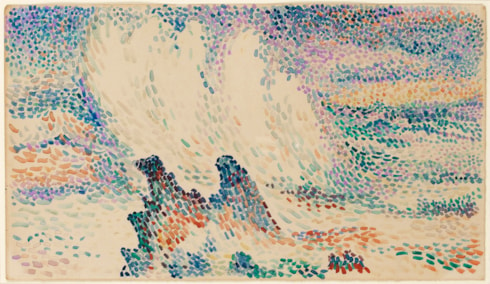
Hippolyte PETITJEAN
Mâcon 1854 - Paris 1929
Biography
Hippolyte Petitjean left school at thirteen and began his training as a draughtsman in his native Mâcon while working as an apprentice housepainter. In 1872 he won a grant to study in Paris, where he continued his training at the Ecole des Beaux-Arts, in the studio of the academic painter Alexandre Cabanel. In 1886 he joined the group of artists known collectively as the Neo-Impressionists, led by Paul Signac and Georges Seurat. (The term ‘Neo-Impressionism’ had been coined by the art critic Félix Fénéon in a review of the last Impressionist exhibition in 1886, in which divisionist paintings by Seurat, Signac and Camille Pissarro were hung together in one room.) Petitjean enjoyed a close friendship with Seurat, whose influence is particularly noticeable in the younger artist’s dark conté crayon drawings of this period. In his mature work, he continued to remain true to the pointillist techniques of Seurat, although his compositions were also influenced by the work of the Symbolist painter Pierre Puvis de Chavannes. Petitjean exhibited at the Salon des Artistes Indépendants in Paris from 1891 onwards, and the following year took part in a number of small gallery exhibitions devoted to the Neo-Impressionist artists. He also contributed to exhibitions in Belgium (where he showed with the avant-garde group of artists Les XX in 1893 and its successor Le Libre Esthétique in 1898), Sweden and Germany.
Unlike many of his colleagues, Petitjean struggled financially for most of his career, and lived in relative poverty, only earning a modest salary as an art teacher. It was not until the sale of some of his paintings at a group exhibition of Neo-Impressionist artists at the Galerie Durand-Ruel in 1899 that he achieved a small measure of financial stability, but later years still found sales few and far between. In a notebook in which the artist carefully recorded his output between 1886 and his death, numerous paintings, drawings and watercolours are listed as having been being gifted or sold to creditors in exchange for services, or to pay bills, while in several years no sales are recorded at all. After 1917 Petitjean’s output slowed considerably, although his work continued to be exhibited with the Neo-Impressionists.
Petitjean maintained an adherence to Neo-Impressionist principles throughout his career, even after the decline in the movement’s critical fortunes following Seurat’s death in 1891. Not long after this, some members of the group, notably Camille Pissarro and his son Lucien, started to become disillusioned with the rigid demands of the pointillist technique. Yet despite Pissarro’s comments in a letter to Lucien written in January 1894 (‘I will give you the details of what passed between Petitjean and Signac; this is only the beginning of disagreeable discussions among the Neos, for Petitjean completely agrees with our view that there is no future in a method as constricted as that of the dot exclusively!’1), Petitjean seems never to have abandoned pointillism as a method of artistic expression. In his survey of the Société des Artistes Indépendants, published in 1920, the scholar and critic Gustave Coquiot noted that ‘In the phalanx of neo-impressionists, M. Petitjean ranks very high. He is best known for his Bathers, of pure classical style, and for his vividly coloured landscapes.’ The artist continued to exhibit his work regularly at the Salon des Indépendants until the very end of his career. In May 1929, shortly before his death, an exhibition of twenty-eight of his works was mounted at a Parisian gallery, from which one painting was purchased by the State for the Musée du Luxembourg.
Although he lived to the age of seventy-five, Petitjean was never very prolific as a painter, with an oeuvre of around 350 paintings, although some of these were rather large in scale. His subject matter included landscapes, urban scenes, mythological subjects and, occasionally, portraits. These works were often preceded by several preparatory studies, usually made en plein-air, though the paintings themselves were almost always executed in his large Parisian studio, built with the proceeds from the sale of two paintings by his friend Seurat.
In 2015-2016 a major Petitjean retrospective was mounted at the Musées des Mâcon, which today holds a substantial collection of the artist’s work, amounting to some 117 paintings and drawings.







